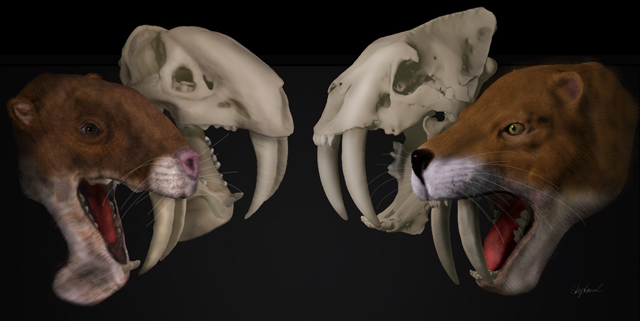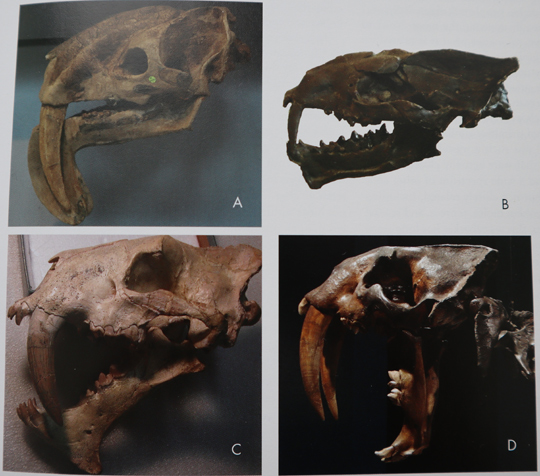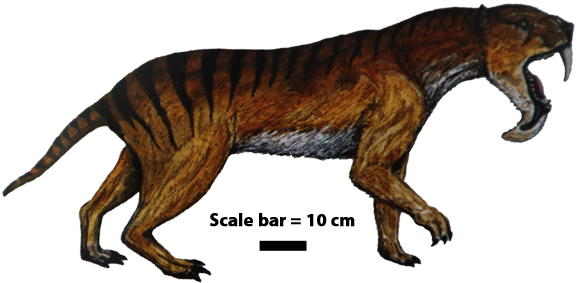Thylacosmilus atrox – A Specialist Scavenger of Large Carcases
Huge canines in predatory mammals has developed on several occasions within the Class Mammalia. Indeed, enormous sabre-like teeth can be found in the fossil record long before placentals and marsupials evolved, a case in point being the gorgonopsids of the Late Permian. However, when the various types of mammal that developed such over-sized front teeth in their upper jaws are compared, it seems that not all sabre-toothed mammals were the ferocious predators that palaeontologists thought them to be.
Studying Thylacosmilus atrox
Writing in the open access, on-line journal “PeerJ” researchers from the University of Birmingham, Bristol University and the Vanderbilt University (Nashville, Tennessee), conclude that the South American “marsupial sabre-tooth”, Thylacosmilus atrox may have been a scavenger, using its huge upper canines to eviscerate carcases before removing internal organs with a large tongue.
The South American Marsupial Thylacosmilus may not have been an Active Predator

Picture credit: Stephan Lautenschlager/University of Birmingham
Thylacosmilus atrox – A Very Peculiar Carnivore
Thylacosmilus (pronounced Thy-lak-o-smile-us), is a member of the extinct Order Sparassodonta and only distantly related to the marsupials of Australia. Its fossils come mostly from northern Argentina, and it lived during the Late Miocene and Pliocene Epochs. Described as a jaguar-sized marsupial with huge maxillary canines, bite force studies had indicated that, for its size, it had a relatively weak bite, much lower than modern, large felids.
Whilst most palaeontologists would agree that the placental genus Smilodon was an active predator, albeit with a different method of dispatching victims when compared to extant “big cats”. This new research proposes that Thylacosmilus, in contrast, was not a fearsome hunter.
Skull comparisons and an analysis of fossil teeth indicate that, Thylacosmilus, with its generally longer and more slender upper canines, was not able to stab prey that effectively when compared to the likes of Smilodon fatalis. What it lacked in penetration it made up for in pulling power, with a strong “pull-back” action using its jaws to rip apart the bodies of dead animals.
Differences in Behaviour Thylacosmilus and Smilodon
Dr Stephan Lautenschlager (University of Birmingham) explained:
“We found there was a difference in behaviour between the two species: Thylacosmilus’ skull and canines are weaker in a stabbing action than those of Smilodon but stronger in a ‘pull-back’ type of action. This suggests Thylacosmilus was not using its canines to kill with, but to open carcasses. We suspect it was some sort of specialised scavenger, using those canines to open carcasses and perhaps using a big tongue to help extract the innards.”
Convergent Evolution of a Sabre-toothed Skull

Picture credit: Everything Dinosaur/C. R. Prothero/D. R. Prothero
Convergent Evolution
The image (above), shows (A) the skull of Thylacosmilus, (B) the creodont Machaeroides, (C) Hoplophoneus, a member of the Nimravidae from North America and (D) the skull of the sabre-toothed cat Smilodon. This is an example of convergent evolution – the similar body plan has evolved independently in several not closely related species.
The scientists discovered that the maxillary canines of Thylacosmilus were different from the teeth of other sabre-toothed mammals. They were more triangular in shape, like a claw rather than flat like the blade of a knife.
Co-author, Dr Christine Janis (University of Bristol) added:
“The animal has impressive canines, but if you look at the whole picture of its anatomy, lots of things simply don’t add up. It lacks incisors, which big cats today use to get meat off the bone and its lower jaws were not fused together.”
A Life Reconstruction of Thylacosmilus atrox

Picture credit: Everything Dinosaur
A Puzzling Combination of Anatomical Traits
As well as lacking incisors, the researchers found that the molars of Thylacosmilus were proportionately small and not worn along their sides as expected in an animal that fed on meat.
Explaining the significance of this finding, Dr Larisa DeSantis (Vanderbilt University) commented:
“The molars tend to wear flat from the top, rather like you see in a bone crusher. But if you examine the detailed microwear on tooth surfaces, it’s clear that it was eating soft food. Its wear is most similar to that of cheetahs which eat from fresh carcasses and suggests an even softer diet than fed to captive lions. Thylacosmilus was not a bone-crusher and may have instead specialised on internal organs.”
Not a Sparassodont Version of Smilodon
Far from being a sparassodont version of Smilodon, Thylacosmilus probably filled a very different niche in the ecosystem. In addition, to the differences in the skull and the teeth, Thylacosmilus was relatively short-legged and lacked a very flexible spine. These characteristics along with an absence of retractile claws suggests that Thylacosmilus would have struggled to pursue all but the slowest of prey and would have had difficulty pouncing and holding on to victims.
Everything Dinosaur acknowledges the assistance of a media release from the University of Birmingham in the compilation of this article.
The scientific paper: “Thylacosmilus was not a marsupial “saber-tooth predator’ ” by Christine Janis, Borja Figueirido, Larisa DeSantis and Stephan Lautenschlager published in PeerJ.
The award-winning Everything Dinosaur website: Everything Dinosaur.






Leave A Comment